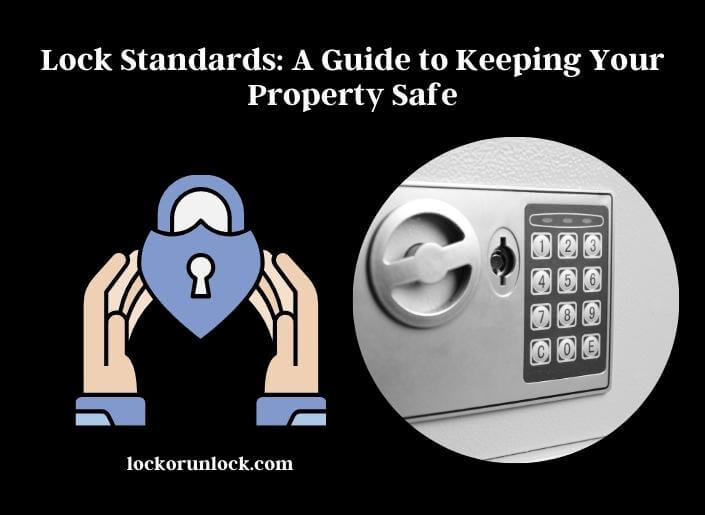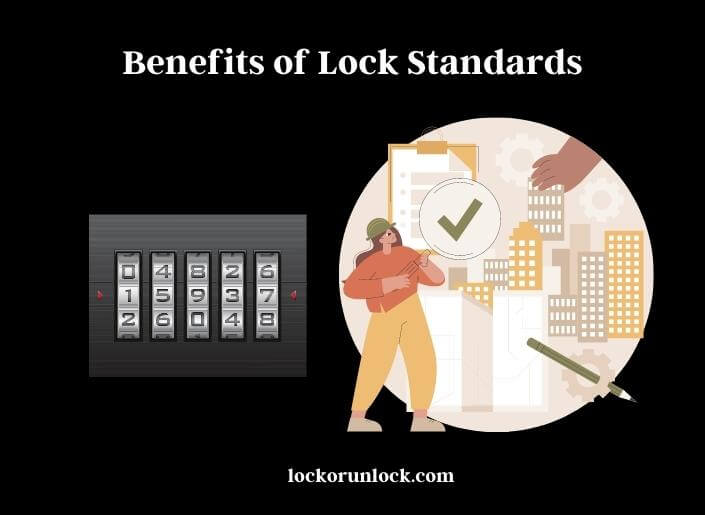Locks play a crucial role in keeping our property secure. They provide a physical barrier that prevents unauthorized access to our homes, offices, and vehicles. Without a reliable lock, our property is at risk of theft and damage. Not all locks are created equal. Some locks may look secure but are vulnerable to various types of attacks, while others may be more reliable and resistant to different types of intrusions.

To help consumers choose the right lock for their property, several organizations have developed lock standards. These standards specify the requirements for locks to meet a particular level of security. They provide a benchmark that consumers can use to evaluate the reliability and effectiveness of different locks.
Lock Standards
Lock standards are guidelines that specify the requirements for locks to meet a particular level of security. These standards are developed by organizations such as the British Standards Institution (BSI), the European Committee for Standardization (CEN), and the Underwriters Laboratories (UL).
Lock standards help to ensure that locks are reliable and resistant to various types of attacks, such as drilling, picking, cutting, and other physical attacks.
There are different types of lock standards, such as British Standards (BS), European Standards (EN), and UL Standards. Each of these standards specifies the requirements for locks to meet a particular level of security.
British Standards (BS)
British Standards are widely recognized as one of the most reliable and trustworthy standards for locks. These standards include BS 3621, BS 8621, and others. To meet these standards, locks must pass specific tests to ensure they meet the required level of security.
For example, locks that meet BS 3621 must be able to withstand various types of attacks, including drilling, picking, and cutting. BS 8621 is designed for locks that don’t require a key to exit but provide a high level of security when locked from the outside.
European Standards (EN)
European Standards are another set of guidelines that specify the requirements for locks to meet specific levels of security. These standards include EN 1303, EN 1634, and others. To meet these standards, locks must pass specific tests to ensure they meet the required level of security. For example, locks that meet EN 1634 must be able to withstand fire for a specific period.
UL Standards
UL Standards are guidelines developed by Underwriters Laboratories, a safety consulting and certification company in the United States. These standards specify the requirements for locks to meet a particular level of security. For example, locks that meet UL 437 must be resistant to drilling, picking, and other physical attacks.
Choosing the Right Lock
Choosing the right lock for your property is crucial to ensure its security. There are several factors to consider when selecting a lock, such as the level of security required, the type of property, and your budget.
Level of Security
The first factor to consider when choosing a lock is the level of security required. For example, a lock for a residential property may not require the same level of security as a lock for a commercial property. The level of security required will also depend on the location of the property, as some areas may have a higher risk of burglary or theft.
Locks that meet specific lock standards, such as British Standards or European Standards, are generally more reliable and resistant to various types of attacks, making them an ideal choice for high-security properties. However, these locks can be more expensive than standard locks.
Type of Property
The type of property you want to secure will also influence the type of lock you choose. For example, a lock for a front door may require a different level of security than a lock for a garage door. Some locks are also designed for specific types of properties, such as commercial properties or vehicles.
Budget
Your budget will also play a role in choosing the right lock. Generally, locks that meet specific lock standards are more expensive than standard locks. However, investing in a high-quality lock that meets a particular standard can provide long-term benefits, such as better security and potential insurance discounts.
Additional Features
In addition to meeting specific lock standards, some locks may offer additional features that can enhance their security. For example, some locks may have anti-drill plates to prevent drilling, while others may have hardened steel shackles to resist cutting. Some locks may also have additional features, such as smart locks that allow remote access control or keyless entry.
Benefits of Lock Standards
Lock standards refer to a set of guidelines and specifications that ensure the quality and functionality of locks used in various applications. These standards are important for several reasons, including:

Improved Security
Lock standards ensure that locks are designed and built to withstand various forms of attack and manipulation. This means that they are more secure and reliable than non-standard locks.
Interoperability
Lock standards ensure that locks and keys from different manufacturers can work together. This is important for large-scale facilities that use multiple types of locks and need to be able to easily rekey or replace locks as needed.
Consistency
Lock standards ensure that locks are manufactured to a consistent level of quality, which reduces the likelihood of defects or failures. This is particularly important for high-security applications where even a small flaw in a lock could compromise the entire system.
Compliance
Lock standards ensure that locks meet legal and regulatory requirements, such as those related to fire safety, accessibility, and building codes. Compliance with these standards is often required by law or by insurance policies. Lock accessories are add-ons that help enhance the security and convenience of your locks.
Peace of Mind
Knowing that locks meet established standards can give people peace of mind that their property and assets are secure. This is particularly important for homeowners, businesses, and government agencies that have a lot to lose if their security is compromised.
Conclusion
Lock standards are guidelines that specify the requirements for locks to meet a particular level of security. British Standards, European Standards, and UL Standards are examples of these guidelines that ensure locks are reliable and resistant to various types of attacks. Choosing a lock that adheres to a specific lock standard provides several benefits, including better security and potential insurance discounts.
When selecting a lock, it is essential to consider factors such as the level of security required, the type of property, and your budget. Additional features, such as anti-drill plates, hardened steel shackles, and smart locks, can also enhance a lock’s security.
If you ask the question about amazon hub lockers a safe? See here to know the answer.
FAQs
How are Lock Standards Determined?
Lock standards are determined through a series of tests and evaluations designed to measure a lock’s resistance to various forms of attack, such as drilling, picking, and bumping. The results of these tests are used to assign a rating or grade to the lock, which indicates its level of security.
What are the Different Types of Lock Standards?
There are several different types of lock standards, including residential, commercial, and high-security. Residential standards are typically used for locks on homes and apartments, while commercial standards are used for locks on buildings such as offices and retail stores. High-security standards are used for locks on facilities that require the highest level of protection, such as government buildings and military installations.
What is the Difference Between a Lock Rating and a Lock Grade?
A lock rating is a numerical score assigned to a lock based on its performance in various tests. A locked grade, on the other hand, is a letter designation that indicates the level of security a lock provides. Grades range from Grade 1 (the highest level of security) to Grade 3 (the lowest level of security).
Do All Locks Need to Meet a Locked Standard?
No, not all locks are required to meet a locked standard. However, locks that are used in high-risk environments, such as banks, government buildings, and military installations, are typically required to meet specific lock standards to ensure the highest level of security. Additionally, many insurance companies require that certain types of locks be used in order for coverage to be valid.
You might also like:

I and my buddies were actually looking at the great guides located on your website while then got a horrible feeling I had not expressed respect to the web site owner for those secrets. All the women are actually as a consequence excited to study them and have actually been loving these things. Appreciate your being so kind and also for selecting varieties of wonderful subjects most people are really wanting to learn about. My personal honest regret for not saying thanks to you earlier.